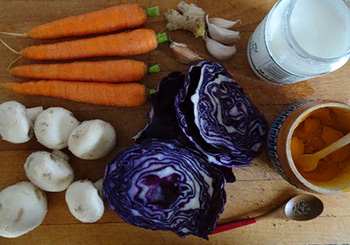Some signs that your gut may be in trouble include:
- An upset stomach e.g. bloating or gas
- Losing or gaining weight without changing your diet or exercise routine
- Poor sleep or insomnia
- Food intolerances
Let’s look at how to improve your gut health by making a simple but healing vegetable broth. First, I’ll explain how the different ingredients support a healthy gut and then share how to make the recipe.
Gut-Healing Properties of Vegetable Broth
I’ve used the following ingredients in this recipe: cabbage, mushrooms, carrots, garlic, miso paste, ginger, coconut oil, and turmeric.
For quick access, here is some segments from the above link:
(to add my notes)
- Gut-Healing Properties of Cabbage: Cabbage is probably one of the best-known vegetables for being gut healing. The soluble fiber it contains is great for feeding the friendly gut bacteria and the insoluble fiber helps to maintain the digestive system by promoting regular bowel movements. Cabbage is also high in L-glutamine, a building block of protein, that helps to heal the lining of the gut.
- Gut-Healing Properties of Mushrooms: Mushrooms have been used in medicinal remedies for thousands of years. In terms of gut healing, mushrooms help fight bacteria which helps to keep a healthy microbiome. They are also good prebiotics that stimulates probiotics in the gut.
- Gut-Healing Properties of Carrots: Carrots contain pectin which is a soluble fiber. This slows down your digestion of starch and sugar. It also feeds the good bacteria in your gut helping your gut cells to stay healthy. Consuming carrots regularly can even prevent the formation of a gastric ulcer and other digestive issues.
- Gut-Healing Properties of Garlic: Garlic has been used in medicine for over 5,000 years and it is a superfood on many levels but is especially good for the gut. That’s partly because garlic is high in a non-digestible carbohydrate called inulin that feeds good bacteria in the gut. This helps your gut function better overall and stops the growth of disease-promoting bacteria.
- Gut-Healing Properties of Miso Paste: Miso paste is made from fermented soybeans making it full of probiotics that improve your gut health. One particular probiotic in miso paste, Aspergillus Oryzae, naturally helps maintain a good-bad bacteria balance.
- Gut-Healing Properties of Ginger: Ginger has a calming effect on the stomach and has gut-healing properties. It also aids digestion and stops food from sitting and fermenting in the intestine by helping your gut move it along. Ginger has over 100 bioactive compounds with anti-inflammatory, antioxidant, and antiemetic properties and it’s many of these that aid digestion. It also stimulates digestive acids and supports the absorption of nutrients.
- Gut-Healing Properties of Coconut Oil: Coconut oil helps to absorb the other nutrients in this broth and also has properties that destroy bad bacteria and lower stomach acid. It also works to restore a healthy balance when there is an imbalance in the gut.
- Gut-Healing Properties of Turmeric: Turmeric has long been used to treat digestive issues in ayurvedic medicine. Turmeric is beneficial to the gut in several ways: it helps the stomach lining, promotes the growth of good gut bacteria, and can prevent bloating or gas while food is being digested.
However, turmeric does negatively affect some people’s digestion, especially where they already have issues. If you know that turmeric doesn’t sit well in your stomach then leave this ingredient out of the broth.
How to Make This Gut-Healing Vegetable Broth
This is a very simple recipe to prepare and should only take five minutes or less. It will then take one hour to cook, roughly 20 minutes to cool, then you need to strain it at the end. You should take this three times a day if you are experiencing gut problems or once a day or every few days if you are looking to maintain your gut health. You can make larger batches if you are going to be taking this regularly to save yourself time. If you divide the quantities below into four serving sizes each portion will have approximately 40 calories.
Ingredients
- 4 Cloves of garlic
 1 Tablespoon of miso paste
1 Tablespoon of miso paste- 1 Inch knob of ginger
- 6 Mushrooms
- 10 oz (250 grams) of cabbage
- 4 Carrots
- A Pinch of black pepper
- 1 Teaspoon of ground turmeric
- 1 Tablespoon of organic virgin coconut oil
- 8 Cups of filtered water
10 Easy Ways to Improve Your Gut Health
If the balance goes awry, especially long term, there is increased risk of the following:
- Digestive inconsistencies, such as bloating, gas, diarrhea, and/or constipation
- Cardiovascular disease
- Weight changes, either loss or gain
- Sensitivity or allergies to foods
- Skin disorders
- Fatigue
- Difficulty with concentration
- Mood swings.
Related: 5 Home Remedies for Diarrhea
The things and situations that contribute to imbalance and poor gut health include:
- Illness
- Eating too many processed foods
- Stress
- Excessive alcohol or drugs
- Aging
- Losing or gaining weight
- Oversea travels
- Some medications.
You can see there are a lot of things that can throw off your microbiome balance. The good news is that there are probably just as many ways to help keep, or even bring our gut flora back to a healthy balance!
1. Probiotics
2.Fermented Foods
3.Less Sugars
4.Regular Exercise
3.Prebiotic Fiber
Probiotics feed on prebiotics, or non-digestible carbohydrates. This emboldens beneficial and necessary bacteria to multiply within the gut. To increase this process, consume prebiotic-rich foods in your diet, such as:
 Bananas
Bananas- Asparagus
- Garlic
- Onion
- Whole grains
- Chicory.
5.Too Much Stress
6.Unnecessary Antibiotics
9.Smoking Habits
10.Meat-wise
If you aren’t already, becoming a vegetarian may improve your gut health. Some studies have noticed differences in the microbiomes from those who eat meat, and those who do not. One reason is believed that a vegetarian diet consists of more prebiotic fiber, which as mentioned above, helps with gut health.

Comments